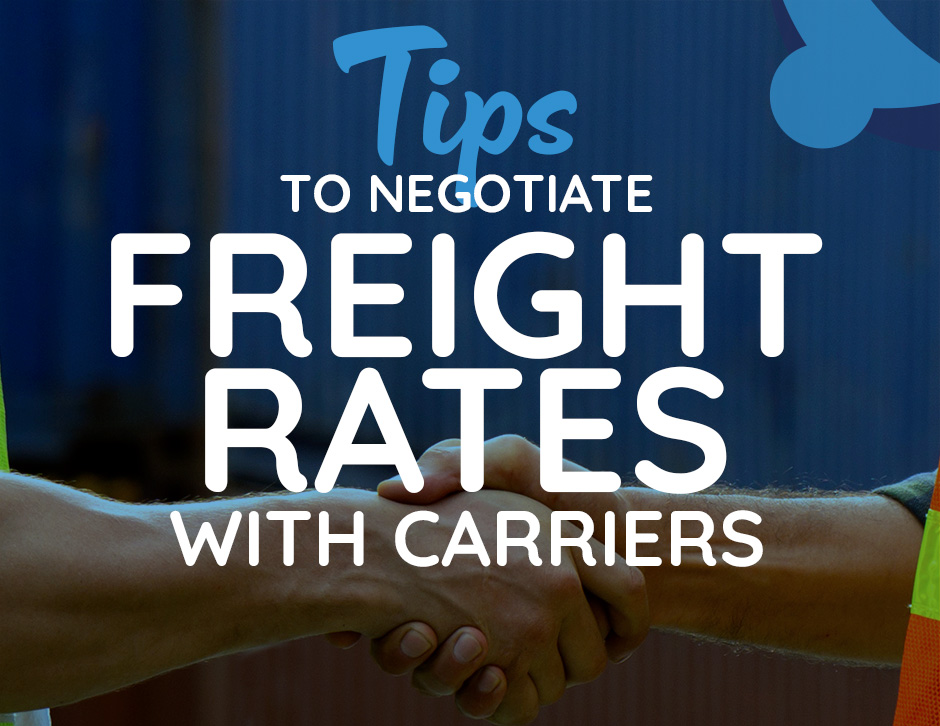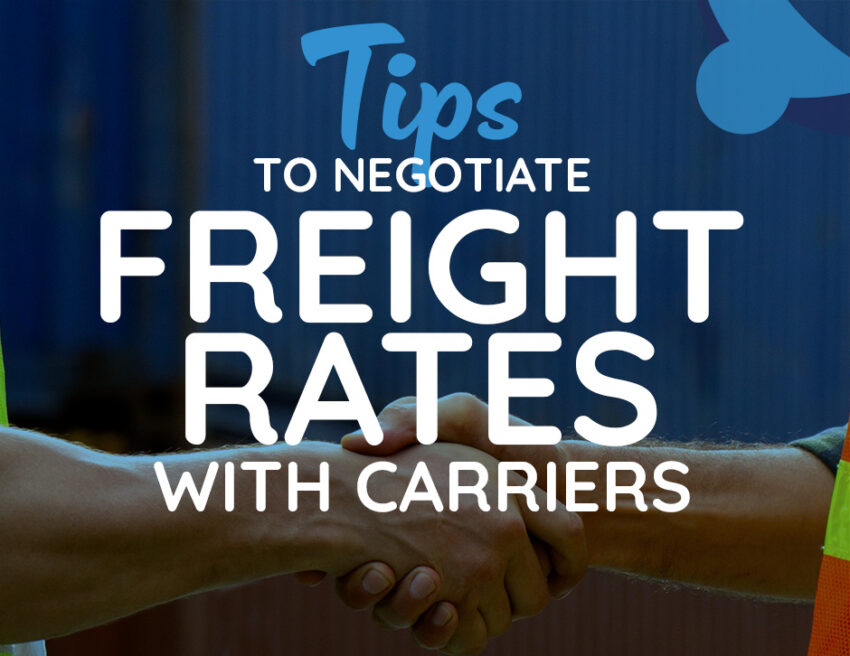Freight forwarding is a complex and dynamic industry where negotiating freight rates with carriers is a critical aspect. Successful negotiation can significantly impact a freight forwarder’s profitability and service quality. Here are some essential tips for independent freight forwarders to negotiate better freight rates with carriers.

Understanding the Market Before Independent Freight Forwarders Start Negotiating
Market Research and Trends
Before entering negotiations, it’s crucial to understand the current market conditions. Freight rates are influenced by various factors such as fuel prices, demand and supply, seasonal trends, and global economic conditions. Independent freight forwarders should conduct thorough market research to grasp these trends. Understanding peak seasons, economic cycles, and market dynamics will give you a clearer picture of the prevailing rates and help you set realistic expectations.
Competitor Analysis
Analyze what your competitors are offering and how they are negotiating with carriers. This can provide insights into the market rates and help you develop a competitive edge. Knowledge of competitors’ strategies can also serve as a leverage point during negotiations, allowing you to highlight unique advantages or services you offer.
Understanding Freight Rates
Components of Freight Rates
Freight rates are composed of several elements, including base freight rate, fuel surcharges, security fees, and other ancillary charges. It’s essential to understand each component to effectively negotiate. Knowing where you can find potential savings or identify unnecessary charges can significantly impact the final rate.
Rate Variability
Freight rates can vary based on shipment volume, weight, dimensions, type of goods, and route. Be aware of how these factors influence the rates. For instance, higher volumes often qualify for bulk discounts, while specialized goods may incur additional handling fees. Understanding these variables allows you to better assess the rates offered and identify areas for negotiation.
Preparing for Negotiation
Gathering Data
Before negotiating, gather all necessary data about your shipping needs. This includes historical shipment data, average shipment volumes, and specific requirements such as temperature control or expedited shipping. Having detailed information at your disposal strengthens your negotiating position and demonstrates to carriers that you are well-prepared and knowledgeable.
Setting Clear Objectives
Define your objectives clearly. Know what you aim to achieve from the negotiation – whether it’s lower rates, better terms, or additional services. Setting clear objectives helps you stay focused during negotiations and ensures that you can measure the success of your efforts.
Developing a Strategy
Develop a negotiation strategy based on your objectives and the information you’ve gathered. Consider different scenarios and prepare your responses. Having a well-thought-out strategy enables you to steer the negotiation in your favor and react effectively to the carrier’s proposals.
Negotiation Strategies
Highlighting Your Value
One effective strategy is to highlight the value your business brings to the carrier. This could include consistent volume, prompt payments, long-term partnerships, or the potential for future business. Emphasize how your business can contribute to the carrier’s growth and stability, making it more attractive for them to offer favorable rates.
Bundling Services
Consider bundling multiple services in your negotiation. For instance, you could negotiate better rates by committing to a combination of sea, air, and land transport services. Bundling can provide carriers with a larger share of your business, incentivizing them to offer better rates across the board.
Exploring Multiple Carriers
Don’t rely solely on one carrier. Explore multiple carriers and use the rates and services offered by others as leverage in your negotiations. Informing carriers that you have other options can prompt them to offer more competitive rates and terms to secure your business.
Building Relationships with Carriers
Long-term Partnerships
Building long-term relationships with carriers can lead to better rates and service. Carriers are more likely to offer favorable terms to partners they trust and have a good history with. Focus on building strong, reliable partnerships by maintaining clear communication, honoring commitments, and fostering mutual trust.
Communication and Transparency
Effective communication is key to successful negotiations. Be transparent about your needs and expectations, and encourage the carrier to do the same. Open communication helps in finding mutually beneficial solutions and avoiding misunderstandings. Additionally, transparency builds trust, which can be a significant advantage in future negotiations.
Handling Objections and Counteroffers
Listening Actively
When carriers raise objections or counteroffers, listen actively to understand their concerns and reasoning. This demonstrates respect and willingness to collaborate. By understanding their perspective, you can address their concerns more effectively and find common ground.
Staying Firm but Flexible
It’s important to stay firm on your key objectives while remaining flexible on less critical aspects. If a carrier counters with a higher rate, consider negotiating other terms that can offset the cost, such as better payment terms, additional services, or flexibility in scheduling.
Finding Win-Win Solutions
Aim for win-win solutions where both parties feel they have gained value. This could involve compromising on certain rates while securing additional benefits that add value to your business. Finding a balanced solution ensures a positive relationship and smoother future negotiations.
Negotiating Beyond Rates
Value-added Services
Sometimes, focusing solely on rates can limit your negotiation potential. Consider negotiating for value-added services like priority loading, better transit times, or enhanced tracking capabilities. These services can add significant value to your offerings and improve customer satisfaction, even if the rates are slightly higher.
Flexibility and Contingencies
Negotiate flexibility and contingency plans into your agreements. This could include options for rerouting shipments, changing delivery schedules, or accommodating last-minute changes without excessive penalties. Flexibility can be invaluable in the dynamic world of freight forwarding and can save costs in the long run.
Utilizing Technology
Freight Rate Management Tools
Leverage technology to streamline the negotiation process. Freight rate management tools can help you compare rates, track market trends, and analyze data more efficiently. These tools provide a data-driven foundation for your negotiations, making it easier to identify the best rates and terms.
For example, Conqueror Freight Network, one of the best logistics networks of our times offers a free online freight rate management tool- FreightViewer, for members that simplifies their task by allowing them to send freight quotations to their clients and partners within less than a few minutes.
Digital Platforms for Collaboration
Digital platforms facilitate better collaboration and communication with carriers. Using platforms that allow for real-time updates, document sharing, and seamless communication can enhance your negotiation process. These platforms also help in maintaining records of negotiations and agreements, ensuring clarity and accountability.
Leveraging Volume and Commitment
Volume Discounts
If you can commit to higher shipment volumes, use this as leverage to negotiate better rates. Carriers often provide discounts for bulk shipments as it ensures steady business for them. Clearly outline your projected volumes and negotiate for volume-based discounts.
Long-term Contracts
Consider negotiating long-term contracts with carriers. Long-term commitments can lead to more favorable rates and terms as carriers value the stability and predictability of continuous business. However, ensure that these contracts are flexible enough to accommodate any changes in your business needs or market conditions.
Conclusion
Negotiating freight rates with carriers is a skill that requires a thorough understanding of the market, detailed preparation, effective communication, and strategic relationship-building. By following these tips, independent freight forwarders can secure better rates and terms, enhance their service offerings, and improve their overall profitability. Remember, successful negotiation is not just about securing the lowest rates but finding the best value for your business and your customers.


